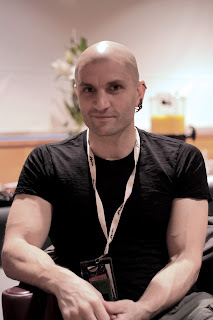Weird Fiction Old, New, and In-Between V: The Ecological Weird – Rafe McGregor
The fifth of six blog posts exploring the literary andphilosophical significance of the weird tale, the occult detective story, and theecological weird. The series suggests that the three genres of weird fiction dramatizehumanity’s cognitive and evolutionary insignificance by first exploring thelimitations of language, then the inaccessibility of the world, and finally thealienation within ourselves. This post introduces the ecological weird.

New Weird?
When I introduced the weird tale as originating in Gothic Romanticism inpart I, I acknowledged that it was a contested claim and there is a similardispute about the relationship between the new weird and the weird tale (or oldweird). ‘New Weird’ was coined by M. John Harrison (b.1945), an author, editor,and critic associated with the New Wave of science fiction in the nineteensixties and seventies. There are claims that the coinage first appeared in Harrison’sintroduction to China Miéville’s (b.1972, pictured) The Tain (2002) andin an internet forum (where the date is usually given as 2003), but regardlessof its precise source, Benjamin Noys and TimothyMurphy notethat the term was initially used to refer exclusively to the work of Miéville (whorejected the label). Those who take Miéville to have inaugurated the new weirdtale usually identify his Perdido Street Station (2000) as the first inthe genre, which was established with the publication of the rest of the Bas-lagTrilogy, The Scar (2002) and Iron Council (2004). Literarycritic S.T. Joshi, who has been almost single-handedly responsible for contemporarycritical and academic interest in both H.P. Lovecraft and weird fiction alsorejects the term, preferring ‘modern weird tale’. Joshi argues that there wasno break between the old and new (and no in-between, as I suggest throughoutthis series), but that later authors simply breathed new life into the genreperfected by Lovecraft.
Part of the process of revitalisation described by Joshi involved thepublication of successful weird novels. Lovecraft’s longest narrative was Atthe Mountains of Madness (serialised in Astounding Stories inFebruary, March, and April 1936), which is approximately forty thousand wordslong, and his next longest The Shadow over Innsmouth (first published asa novella with a print run of two hundred in 1936 and then posthumouslyabridged for the January 1942 issue of Weird Tales), which isapproximately twenty-seven thousand words long, placing both at the short endof the novella format. Joshi maintains that the weird tale is essentially atale – i.e., a short story – and I agree that horror fiction in general is muchbetter suited to the short format (and crime fiction to the novella format).The reinvigoration of the weird tale after 1940 saw the publication ofnovel-length weird tales such as Shirley Jackson’s The Haunting of HillHouse (1959), Anne Rice’s Interview with the Vampire (1976), Ramsay Campbell’sIncarnate (1983), T.E.D. Klein’s The Ceremonies (1984), and CliveBarker’s Weaveworld (1987). Crucially for Joshi, these exemplary weirdnovels have nothing in common (beyond, presumably, meeting the criteria for hisdefinition of weird fiction), which is why he is reluctant to admit the birthof a new genre or even a transformation of the original genre. Roger Luckhurst prefers the idea of aLovecraftian revival rather than a new weird, drawing particular attention tothe work of Caitlín R. Kiernan (whom I discussed in part II).

Tales of the City?
Jeff VanderMeer (b.1968, pictured), who is one of the three authors most oftenassociated with the new weird – along with Miéville and Kelly Link (b.1969,pictured) – favours the term and refers to PerdidoStreet Station as the first ‘commercially acceptable’ new weird tale (invirtue of its length). VanderMeer defines the new weird as urban speculativefiction that is based on complex real-world models, employs elements of thesurreal or transgressive, and is acutely (if not overtly) aware of the politicsof the modern world. In thissense, it is both a continuation and transformation of the weird tale’s pursuitof an abstruse and possibly even unattainable understanding of thesupra-natural and the un-rational. Noys and Murphy regard the new weird asindicative of precisely such a transformation, although they trace it beyond to the nineteen eighties, locating its originin the work of Thomas Ligotti, Barker, and Brian Evenson. Like me (see partII), they foreground Ligotti’s contribution, claiming that he ‘formulated a newand desolate conception of a fundamentally chaotic universe’. James Machin also supports theclassification, but pushes the origins back further still, to New Wave sciencefiction, which began in the nineteen sixties, was characterised by aself-conscious appropriation of literary modernism, and was associated with thework of Michael Moorcock, Harrison, Harlan Ellison, J.G. Ballard (1930-2009),Ursula Le Guin, Samuel Delany, and Roger Zelazny.
Where, then, does this leave us…new or not, urban or not, Miéville ormore? My view is that Noys, Murphy, VanderMeer, and Joshi are right toforeground the relatively recent development of the novel format in weirdfiction. Without it, the genre is unlikely to survive much longer in thetwenty-first century and there are unlikely to be repeats of 2018, for example,when three contemporary weird tales appeared on the big and small screen (discussedin my review of Guillermo del Toro’s The Shape of Water). Which is not to belittlethe wonderful short stories of authors like Link and Sarah Monette – the genreneeds both formats. With that in mind, however, there has been anoveremphasis on Miéville’s work in discussions of the new weird because heprefers the novel format and often writes very long novels – as opposed toVanderMeer’s, which are much shorter, and Link, who remains faithful to the shortstory. The focus on Miéville at the expense of others has also created theoveremphasis on the urban to which VanderMeer falls foul in defining the newweird. Miéville’s predilection for the urban – in King Rat (1998), the Bas-lagTrilogy (2000-2004), Un Lun Dun (2007), The City & the City (2009),TheLast Days of New Paris (2016), and other stories – has produced a misleading associationof genre and setting. The urban is more closely aligned with the steampunk genre and the Bas-lagTrilogy more exemplary of that genre than of weird fiction (although thetwo are quite obviously related), perhaps even its most accomplished novels afterWilliam Gibson and Bruce Sterling’s The Difference Engine (1990).

Weird Ecology?
Miéville is nonetheless rightly identified as one of the best authors ofweird fiction in the twenty-first century, with his initial contribution being KingRat rather than Perdido Street Station. There is of course someirony in VanderMeer defining the new weird in terms of urban settings andthemes because it was precisely his work – specifically, his Southern ReachTrilogy – which demonstrated that whether or not the new weird was new, itcould function as well if not better in rural settings and with biologicalthemes. Annihilation, Authority, and Acceptance were allpublished in 2014, the cinematic adaptation of Annihilation (directed by Alex Garland)was released by Paramount Pictures and Netflix in 2018, and (as with so manysuccessful trilogies) the Southern Reach will become a quartet with thepublication of Absolution next month. VanderMeer’s well-deserved successhas, in the second and third decades of the twenty-first century, shifted the initialemphasis on the urban to the rural and highlighted links to what is variouslycalled eco-fiction, cli-fi, or climate change fiction, a category of sciencefiction (and, perhaps, literature) that probably began with Jules Verne’s Sansdessus dessous (1889, translated as The Purchase of the North Pole).VanderMeer’s bridging of the divide between eco-fiction and weird fiction hasled critics to speak of his ecologically minded weirdfiction and ‘weird ecology’, to describe him as the weird Thoreau, and to associate his workwith global weirding.
Although I shall discuss the precursors to and origins of the SouthernReach Trilogy in more detail in part VI, I want to recommend two thingshere that will conclude my answers to the questions raised earlier. First, thatthe ‘new weird’ and its affiliation with Miéville and the urban be retired infavour of the ecological weird. If weird fiction (and, indeed, literature) isto, in VanderMeer’s words, remain acutely aware of the politics of themodern world, then it must reflect on the conditions of its own productionin the Anthropocene and on the kind of issues I discussed in my essay on climate change culture, published in TQF76 inApril. This does not restrict the category to stories with a rural setting orbiological themes and reinforces the value of Miéville’s King Rat, whichis outstanding ecological weird fiction. Replacing ‘new weird’ with ‘ecologicalweird’ also reveals what seems to me to be a clearer origin of thetransformation of the weird tale, which I locate in Ballard’s four prototypicalclimate fiction novellas: The Wind from Nowhere (1961), The DrownedWorld (1962), The Burning World (1964), and The Crystal World.Ballard was dismissive of The Wind from Nowhere, but aside from beinghis first published novella, Kate Marshall makes a convincing case forit anticipating what I am calling the ecological weird and what she calls novelsby aliens. Second, as with occult detective fiction, the ecological weirdis a category within weird fiction and, as such, requires only a minor revisionof my previous definition: the ecological weird is philosophical in virtueof presenting or representing a fully-fledged and fleshed-out worldview,generically hybrid in character, and foregrounds the alienation withinourselves. It is to this (self-)alienation that I turn in part VI.
Recommended Reading
Fiction
Kelly Link, Get inTrouble: Stories, Canongate Books (2015).
Jeff VanderMeer, Finch: A Novel, Underland Press (2009).
Nonfiction
Jeff VanderMeer, The New Weird: ‘It’s Alive?’, The New Weird,Tachyon Publications (2008).
S.T. Joshi, The Modern Weird Tale: A Critique of Horror Fiction,McFarland & Company (2001).
M. John Harrison, Wish I Was Here: An Anti-Memoir, Serpent’s Tail(2023).



